8 books about Adapting
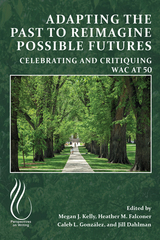
Adapting the Past to Reimagine Possible Futures
Celebrating and Critiquing WAC at 50
Megan J. Kelly
University Press of Colorado, 2024
Developed from presentations at the Fifteenth International Writing Across the Curriculum Conference, this edited collection celebrates the 50th anniversary of the WAC movement while also identifying innovative directions for writing pedagogies, program building and impact, and program mobilization. Contributors reflect on the evolution of WAC as an educational movement as well as the challenges and possibilities facing WAC programs as they respond to the shifting contexts of higher education. The chapters in this collection—found in sections on faculty development, classroom implications, and institutional considerations—offer a range of practices, pedagogies, frameworks, and models for readers who are invested in building and sustaining WAC programs that impact their college and university campuses through cultures of writing. Adapting the Past to Reimagine Possible Futures engages topics such as program assessment, professionalization, and interdisciplinary collaborations, and connections with creative writing. Its 17 chapters testify to WAC’s persistence, resilience, and impact in a dynamic educational landscape.
[more]

Adapting to America
Catholics, Jesuits, and Higher Education in the Twentieth Century
William P. Leahy, SJ
Georgetown University Press, 1991
Professor Leahy recounts the academic tensions between religious beliefs and intellectual inquiry, and explore the social changes that have affected higher education and American Catholicism throughout this century. He attempts to explain why the significant growth of Catholic colleges and universities was not always matched by concomitant academic esteem in the larger world of American higher education.
[more]
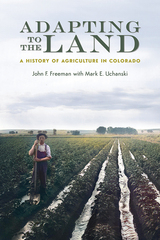
Adapting to the Land
A History of Agriculture in Colorado
John F. Freeman
University Press of Colorado, 2021
Adapting to the Land examines the extent to which Colorado agriculturists adapted to or stretched beyond the limits of land and water. Historian John F. Freeman and horticultural scientist Mark E. Uchanski document the state’s agricultural history and provide context for the shift away from traditional forms of agriculture to the use of synthetic fertilizers, herbicides, and pesticides—and, most recently, to more values-driven practices to support the burgeoning popularity of natural and organic foods. This shift has resulted in the establishment of the global organic food processing and distribution industry, which has roots in Colorado.
Ancestral Puebloans farmed and grazed within the limits of nature. Early settlers adjusted their cultivation methods through trial and error, while later agriculturists relied on research and technical advice from the Colorado Agricultural College. As part of wartime mobilization, the federal government prompted farmers to efficiently increase yields. To meet the demand for food and fiber scientific and technical innovations led to the development of new plant cultivars and livestock breeds, advances in mechanization, and widespread use of synthetic amendments. Increasing concern over soil fertility and the loss of irrigation water to urbanization contributed to more changes. Despite, or perhaps because of, what we see today along the Front Range, Colorado may still have a chance to slow or even reverse its seemingly unrestrained growth, creating a more vibrant, earth-friendly society in which agriculture plays an increasingly significant part. Scientific discoveries and innovations in regenerative cultivation are clearing the path to a more sustainable future.
Adapting to the Land adds an ecological and horticultural perspective to historical interpretations of recurring agricultural issues in the state and tracks the concept of stewardship, suggesting that spiritual beliefs continue to contribute to debates over acceptable agricultural practices and the effects of urbanization upon the land. This book will be a key resource for students, scholars, and general readers interested in agricultural and Colorado history, sustainability, and rural sociology.
Ancestral Puebloans farmed and grazed within the limits of nature. Early settlers adjusted their cultivation methods through trial and error, while later agriculturists relied on research and technical advice from the Colorado Agricultural College. As part of wartime mobilization, the federal government prompted farmers to efficiently increase yields. To meet the demand for food and fiber scientific and technical innovations led to the development of new plant cultivars and livestock breeds, advances in mechanization, and widespread use of synthetic amendments. Increasing concern over soil fertility and the loss of irrigation water to urbanization contributed to more changes. Despite, or perhaps because of, what we see today along the Front Range, Colorado may still have a chance to slow or even reverse its seemingly unrestrained growth, creating a more vibrant, earth-friendly society in which agriculture plays an increasingly significant part. Scientific discoveries and innovations in regenerative cultivation are clearing the path to a more sustainable future.
Adapting to the Land adds an ecological and horticultural perspective to historical interpretations of recurring agricultural issues in the state and tracks the concept of stewardship, suggesting that spiritual beliefs continue to contribute to debates over acceptable agricultural practices and the effects of urbanization upon the land. This book will be a key resource for students, scholars, and general readers interested in agricultural and Colorado history, sustainability, and rural sociology.
[more]
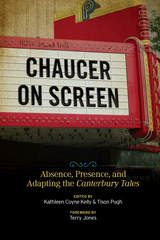
Chaucer on Screen
Absence, Presence, and Adapting the Canterbury Tales
Kathleen Coyne Kelly and Tison Pugh
The Ohio State University Press, 2016
Unlike William Shakespeare, Jane Austen, Charles Dickens, and other great authors who have enjoyed continued success in Hollywood, Geoffrey Chaucer has largely been shunted to the margins of the cinematic world. Chaucer on Screen: Absence, Presence, and Adapting the Canterbury Tales, edited by Kathleen Coyne Kelly and Tison Pugh, investigates the various translations of Chaucer and the Canterbury Tales to film and television, tracing out how the legacies of the great fourteenth-century English poet have been revisited and reinterpreted through visual media. Contributors to this volume address the question of why Chaucer is so rarely adapted to the screen, and then turn to the occasional, often awkward, attempts to adapt his narratives, including such works as Michael Powell and Emeric Pressburger’s lyrical A Canterbury Tale (1944), Pier Paolo Pasolini’s still-controversial I racconti di Canterbury (1972), Bud Lee’s soft-core The Ribald Tales of Canterbury (1985), Brian Helgeland’s A Knight’s Tale (2001), and BBC television productions, among others. Chaucer on Screen aims to rethink some of the premises of adaptation studies and to erase the ideological lines between textual sources and visual reimaginings in the certainty that many pleasures, scholarly and otherwise, can found in multiple media across disparate eras.
[more]
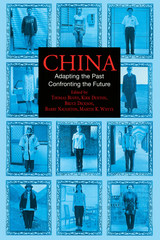
China
Adapting the Past, Confronting the Future
Thomas Buoye, Kirk Denton, Bruce Dickson, Barry Naughton, and Martin K. Whyte, Editors
University of Michigan Press, 2002
Completely updated, China: Adapting the Past, Confronting the Future is the latest in a series of classroom units on China from the Center of Chinese Studies at The University of Michigan. It is not only ideal for courses on contemporary China but also an excellent supplement for courses in area studies, international affairs and economics, and women's studies.
Each section, in addition to essay and excerpts, also includes a bibliography of additional topical works as well as suggestions for complementary video and internet teaching resources.
Geography and History: Presents a broad sketch of Chinese history from earliest times and a detailed discussion of the forces that have shaped modern Chinese history. Geography sharpens the focus to China’s rich ecological and ethnic diversity.
Politics: Addresses political issues in post-Tiananmen China, including corruption, human rights, US-China relations, democratic reform, and religious and political dissidents.
Society: Examines contemporary social problems that have emerged in the post-Mao era, including divorce, migrant labor, family planning, problems facing Chinese women, and the proliferation of Chinese and Western religions.
Economy: Assesses the post-Mao economy after twenty years of experimentation and reform, including development of private enterprises, income disparities, case studies in rural and urban economic development, and the prospects for future growth.
Culture: Reviews 20th century Chinese literature, the intersection between politics and the arts, the explosion of popular culture, and changing visual culture in modern China.
Future Trends: Explores the prospects for democratization, generational change in leadership, the direction of modernization, and China’s prospects for political liberalization.
[more]
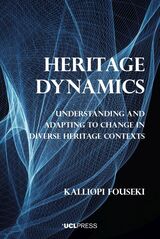
Heritage Dynamics
Understanding and Adapting to Change in Diverse Heritage Contexts
Kalliopi Fouseki
University College London, 2022
A systemic reconsideration of the formation and preservation of heritage.
As a sociocultural concept, heritage flows through cycles of emergence, change, disappearance, and revival. These lifecycles are influenced by heritage environments such as museums, landscapes, cities, and intangible networks of cultural circulation. In Heritage Dynamics, Kalliopi Fouseki develops a new theoretical and methodological framework that will enable heritage scholars and practitioners to unpack the ways and conditions under which heritage changes. Under the contexts of urban cities, residential buildings, museum collections, and subjects of intangible heritage especially concerning flamenco, this work re-orients the consideration of heritage as an object, process, or discourse, towards a more systemic thinking that captures the complexity of this historical-cultural force.
As a sociocultural concept, heritage flows through cycles of emergence, change, disappearance, and revival. These lifecycles are influenced by heritage environments such as museums, landscapes, cities, and intangible networks of cultural circulation. In Heritage Dynamics, Kalliopi Fouseki develops a new theoretical and methodological framework that will enable heritage scholars and practitioners to unpack the ways and conditions under which heritage changes. Under the contexts of urban cities, residential buildings, museum collections, and subjects of intangible heritage especially concerning flamenco, this work re-orients the consideration of heritage as an object, process, or discourse, towards a more systemic thinking that captures the complexity of this historical-cultural force.
[more]
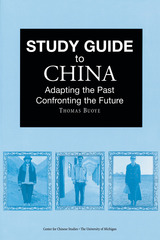
Study Guide to China
Adapting the Past, Confronting the Future
Thomas Buoye
University of Michigan Press, 2003
China: Adapting the Past, Confronting the Future combines original essays by leading experts with excerpts from primary sources, the latest scholarship, Chinese literature, and Western media reports to provide a comprehensive textbook on contemporary China. Completely updated, China: Adapting the Past, Confronting the Future is the latest in a series of classroom units on China from the Center of Chinese Studies at The University of Michigan. It is not only ideal for courses on contemporary China but also an excellent supplement for courses in area studies, international affairs and economics, and women's studies.
Each section, in addition to essay and excerpts, also includes a bibliography of additional topical works as well as suggestions for complementary video and internet teaching resources.
Each section, in addition to essay and excerpts, also includes a bibliography of additional topical works as well as suggestions for complementary video and internet teaching resources.
[more]

Take Two
Adapting the Contemporary American Novel to Film
Barbara Tepa Lupack
University of Wisconsin Press, 1994
From Edwin S. Porter to Mike Nichols, from D. W. Griffith to Steven Spielberg, American filmmakers have looked to the novel for story ideas.
Different in its complexities from the classic novels of Dickens, London, and Tolstoy to which earlier filmmakers turned, the contemporary American novel poses a real challenge to the filmmaker, who must translate its occasionally unfilmable essence for a new audience. Take Two closely analyzes the adaptations of ten such works: Catch-22, One Flew over the Cuckoo's Nest, Slaughterhouse-Five, Being There, The World According to Garp, Sophie’s Choice, The Color Purple, Ironweed, Tough Guys Don't Dance, and Billy Bathgate.
Different in its complexities from the classic novels of Dickens, London, and Tolstoy to which earlier filmmakers turned, the contemporary American novel poses a real challenge to the filmmaker, who must translate its occasionally unfilmable essence for a new audience. Take Two closely analyzes the adaptations of ten such works: Catch-22, One Flew over the Cuckoo's Nest, Slaughterhouse-Five, Being There, The World According to Garp, Sophie’s Choice, The Color Purple, Ironweed, Tough Guys Don't Dance, and Billy Bathgate.
[more]
READERS
Browse our collection.
PUBLISHERS
See BiblioVault's publisher services.
STUDENT SERVICES
Files for college accessibility offices.
UChicago Accessibility Resources
home | accessibility | search | about | contact us
BiblioVault ® 2001 - 2024
The University of Chicago Press









